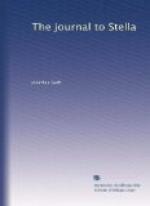15 It is not clear which of several Lady Gores is here referred to. It may be (1) the wife of Sir William Gore, Bart., of Manor Gore, and Custos Rotulorum, County Leitrim, who married Hannah, eldest daughter and co-heir of James Hamilton, Esq., son of Sir Frederick Hamilton, and niece of Gustavus Hamilton, created Viscount Boyne. She died 1733. Or (2) the wife of Sir Ralph Gore, Bart. (died 1732), M.P. for County Donegal, and afterwards Speaker of the Irish House of Commons. He married Miss Colville, daughter of Sir Robert Colville, of Newtown, Leitrim, and, as his second wife, Elizabeth, only daughter of Dr. Ashe, Bishop of Clogher. Or (3) the wife of Sir Arthur Gore, Bart. (died 1727), of Newtown Gore, Mayo, who married Eleanor, daughter of Sir George St. George, Bart., of Carrick, Leitrim, and was ancestor of the Earls of Arran.
16 “Modern usage has sanctioned Stella’s spelling” (Scott). Swift’s spelling was “wast.”
17 Mrs. Manley.
18 Swift’s own lines, “Mrs. Frances Harris’s Petition.”
19 Thomas Coote was a justice of the Court of Queen’s Bench, in Ireland, from 1692 until his removal in 1715.
20 Probably a relative of Robert Echlin, Dean of Tuam, who was killed by some of his own servants in April 1712, at the age of seventy-three. His son John became Prebendary and Vicar-General of Tuam, and died in 1764, aged eighty-three. In August 1731 Bolingbroke sent Swift a letter by the hands of “Mr. Echlin,” who would, he said, tell Swift of the general state of things in England.
21 “This column of words, as they are corrected, is in Stella’s hand” (Deane Swift).
Letter 33.
1 Swift’s verses, “The Description of a Salamander,” are a scurrilous attack on John, Lord Cutts (died 1707), who was famous for his bravery. Joanna Cutts, the sister who complained of Swift’s abuse, died unmarried.
2 See Letter 6, note 5.
3 Fourteen printers or publishers were arrested, under warrants signed by St. John, for publishing pamphlets directed against the Government. They appeared at the Court of Queens Bench on Oct. 23, and were continued on their own recognisances till the end of the term.
4 Robert Benson (see Letter 6, note 36).
5 “The South Sea Whim,” printed in Scott’s Swift, ii. 398.
6 See Letter 21, Apr. 24, 1711, Letter 22, Apr. 28, 1711, and Letter 34, 17 Nov. 1711.
7 Count Gallas was dismissed with a message that he might depart from the kingdom when he thought fit. He published the preliminaries of peace in the Daily Courant.
8 William, second Viscount Hatton, who died without issue in 1760. His half-sister Anne married Daniel Finch, second Earl of Nottingham, and Lord Hatton was therefore uncle to his fellow-guest, Mr. Finch.
9 Crinkle or contract. Gay writes: “Showers soon drench the camblet’s cockled grain.”




